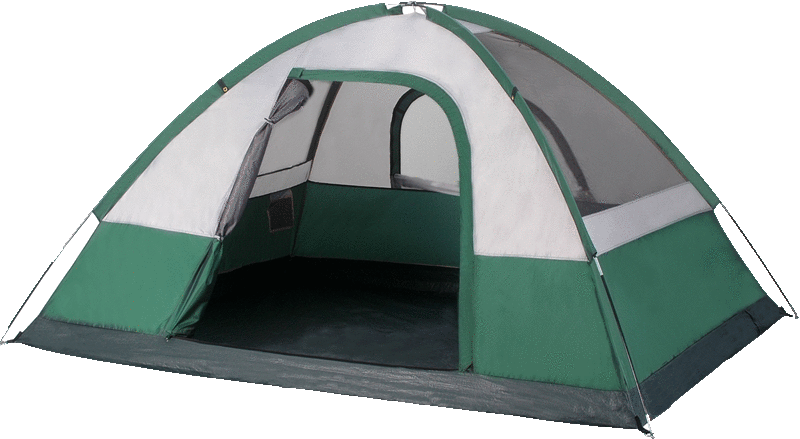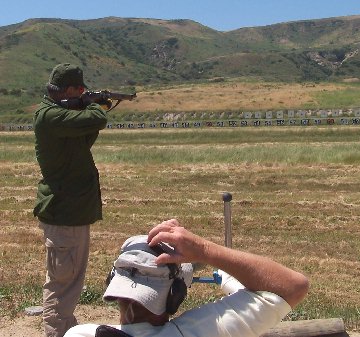I received my introduction to high power rifle shooting not
long after coming to Arizona. I think it was about this time of year in
1989. The introduction did not go smoothly.
I was still in the Air National Guard at the time, and my shop supervisor,
who was involved in high power competition, was rounding up as many of us
guys in the avionics shop as he could, to participate in the M1 Garand
clinic at Rio Salado. This is where I first heard of the opportunity to
buy a Garand through the DCM (now CMP).
On showing up first thing in the morning, we sat through the bleacher talk
familiarizing us with the M1 Garand and the course of fire. We were squadded
up and I got sent to the pits for target service for the first two relays.
Keep in mind that I was still new to Arizona at this time, having recently
moved here from the central coast of California.
Target service for the first two relays was uneventful. Now it was my turn
to shoot. But first a bite to eat, as it was about lunchtime. I had brought
a lunch, but not enough liquids. I didn't realize it at first, but I had gotten
severely dehydrated. Even though I was in the shade down in the pits, the heat
of the day coupled with the physical exertion of pulling the targets up and down
had really dried me out.
I got through 20 rounds of slow fire prone, then 10 rounds of rapid fire sitting,
but I had to beg off the line at that point because I was feeling really sick.
I had a bad headache, and I felt nauseous. My line coach finished the rest of
my shots, while I went and hit someone's water jug again and again and again.
Welcome to Arizona!
Ray Cernansky and Dick Plowden are probably our club's most active high power
rifle shooters. For years they've been trying to get me, and anyone else who'll
listen to them, to shoot high power matches and join them in their addiction.
I've always politely (I hope) begged off. I always thought that it was sort of
a boring form of competition. On top of that, maybe I was just a little
intimidated by what I perceived as a general seriousness on the part of the
competitors and also by the esoteric equipment that practitioners of this
shooting discipline use. I'm talking about the shooting jackets, the strange
shooting glove, the funny scope stands, etc. Not to mention the exotic
iron-sighted "Match Rifles" used in some forms of the sport. But somehow, I'm
now finding myself pulled into this strange world through my interest in the
old bolt-action battle rifles.
So far, my toe-dipping into the world of high power competition has been limited
to firing in Obsolete or Vintage Military Bolt Action matches, plus the matches
I have run for HSC as Military Rifle Fun Shoots. Locally, in the last couple of
years I've shown up for vintage rifle matches at the Rio Salado Sportsman's Club
in east Mesa, the Phoenix Rod & Gun Club at South Mountain, and at the Prescott
Sportsman's Club up in Prescott. I keep my eye on the event calendars for these
clubs because this type of shoot comes up only once, or maybe a couple of times
a year at each club.
I guess one reason I like to shoot these matches, but I have not become interested
in regular high power, is because I can always blame a bad performance on this old,
foreign, POS that I'm shooting. On the other hand, if I shoot well, it's because
I'm such a great shot that I can overcome the limitations of the old foreign POS!
See, there's no downside!
This past month, I had the opportunity to fire in vintage military matches three
weekends in a row. It's been a hectic month. Because my kids have been joining
me in these shoots, I've been furiously handloading and handloading all month long
to keep three rifles fed with ammo. Plus, one of the matches involved a 3-day
weekend trip to California.
The first match this mad May was Rio Salado's 50 Round Curio and Relic Rifle Match
on May 8th. Next in line originally was a vintage military match at Phoenix Rod &
Gun, but I spoke to Ray Cernansky about a month before the scheduled match and he
told me that the vintage match was canceled. Ray is a member of our club, but he
is also high power director at Phoenix Rod & Gun. He said that too few people
showed up for the last one, so it was being replaced with a 60 shot prone event for
regular high power rifles.
I had a back up plan though. While browsing one of the curio and relic internet
forums, I caught wind that the CMP (Civilian Marksmanship Program) was holding their
first ever CMP Western Games match for Garands, Springfields, and foreign military
rifles at Camp Pendleton, near Oceanside, California. When Ray broke the news of the
cancellation, I told him, "Then I'm heading to Oceanside!"
The final match I had planned for May was up in the cool pines of Prescott. The
Prescott Sportsman's Club was holding a CMP sanctioned Vintage Military Bolt Rifle
Match. I had a lot of fun shooting this match in 2004, where I actually shot well
enough to earn myself a second place plaque. This year, three Martinez boys would be
entering the match.
May 8th: Rio Salado
My fourteen-year-old son Bennet had expressed some interest in getting involved with
the Arizona Junior High Power Rifle Team. He has no experience whatsoever with high
power competition, but he seems to be quite interested in trying his hand with an
AR-15 in a match. However, joining the junior rifle team would involve a lot of MY
time getting him to and from scheduled practices and matches. Quite frankly, I was
unwilling to give up that much of my precious weekend time. On the other hand, I'm
quite willing to take him along on shoots that I'm interested in shooting. Plus,
after firing in a couple vintage military matches, we would get to see whether his
interest would last, or die off.
I had already signed both of us up to shoot in the Camp Pendleton CMP match. The
CMP listed a minimum age requirement of fourteen to participate, so Sam, my
eleven-year-old would have to sit this one out. But since Ben had never been to
a high power match, I decided that he needed to go with me to Rio Salado as an
observer before becoming a high power participant. There he could first learn
the basic conduct of a high power match, plus learn how to do target service in
the pits. That way, he wouldn't be overwhelmed when we showed up at the big
match.
Rio Salado has been running these matches for a number of years. I think I
participated in my first match with them in April 2002. The May 8th match
consisted of the following course of fire, all at 200 yards:
- 10 shots slow fire standing in 10 minutes
- 10 shots rapid fire sitting in 80 seconds
- 10 shots rapid fire prone in 80 seconds
- 20 shots slow fire prone in 20 minutes
Sometimes the Rio Salado match is run with targets whose scoring rings shrink
as you move into the steadier positions, to simulate shooting from longer
ranges, as is normally done in the National Match Course. But the May 8th
match was fired at the NRA SR (short range) rifle target for all stages.
For the slow fire stages, you load one round at a time, take your shot, then
the target disappears while the guys in the pits mark your target. Then it
comes back up, ready for your next shot, but with a marker disk in your last
hole.
In the rapid fire stages, the target stays up for all ten shots. You start
in the standing position and load 5 rounds into your magazine, but you leave
your bolt open. The target actually starts in the half-mast position. Your
signal to get down into the prone or sitting position, to close your bolt
and start shooting, is when the target is hoisted to the full up position.
After firing your first five rounds you need to rapidly reload five more
rounds and continue. The clock keeps ticking. With these old bolt-action
military rifles, the reload is accomplished with a stripper-clip.
Only eight guys ended up showing at the match on this fine Mother's Day morning.
Better sons were probably treating their moms to a nice brunch. Two of the
eight were observers, Ben and another guy who couldn't get his Swiss K-31
sighted-in in time for the match. So we only ran two relays of three. I got
to shoot first, before moving to the pits.
Up to now, my favorite gun for these matches was a 1936 Sako Model 28/30 Finnish
Civil Guard rifle. But head to head testing last year against a 1942 Model 39
SK.Y, which is just a later version of the Finnish Civil Guard rifle, revealed
that the M39 was a better shooter. So the decision was made to campaign with
the M39 this year.
I shot OK in this match, actually pretty good for me. My final score was 434-0x,
or 86.8% of the 500 points possible. This is just a hair less than my best-ever
score with the M28/30.
Ben and I then headed down to the pits to do our pit duty. You'd better believe
that I now make sure to take plenty of water and even some granola bars with me
to the pits! Ben and I worked as a team, and in no time at all he had high power
target service all figured out.
May 14-15: The CMP Western Games
Garands have been used in the National Matches for many years. After eclipsing
the Springfield as the most competitive gun for Service Rifle competition in the
1950's, Garands started getting beat by M14s and M1A's. Then came the reign of
the mouse gun, the AR-15, the gun winning Service Rifle matches today.
It seemed that the competition usefulness of the old WWII and Korean conflict era
veteran had seen its sunset. That all changed in 1998. The CMP started something
big when they created the John C. Garand match and the concept of the CMP Games
matches.
For regular Service Rifle competition, certain accuracy mods such as special
sights, glass bedding, synthetic stocks, and special match barrels are allowed,
as long as the overall exterior appearance of the rifle remains unchanged from
government issue. For the John C. Garand Match and the other CMP Games service
rifle matches, the guns must be as-issued. For Garands, that basically means
that the gun you just bought from the CMP is ready to compete on an equal basis
with everyone else the moment you open the box.
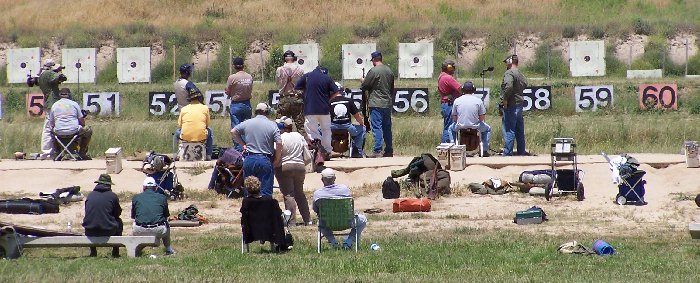
The firing line at the
CMP Western Games, May 14th, 2005.
In 2002, the Springfield Match was added under the banner of the CMP Games, for
as-issued Springfields. And in 2003, the Vintage Military Rifle Match for
as-issued foreign rifles was added to the CMP Games.
The whole idea behind the creation of these CMP Games matches is to bring new
people into the game by stripping away some of the ultra-competitive aspects
of traditional high power competition. There has always been this gulf
separating high power rifle competitors from the people who own an old rifle
or two because of the guns' historical connection. Since playing in this
vintage military rifle game, I've met people from both worlds who know their
side inside and out, but know practically nothing about the other. The CMP
Games are bringing these two groups together.
The CMP Games matches started as sort of a sideshow to the National Matches
at Camp Perry, Ohio. At that first running of the Garand Match, there were
300 entrants. In 2004 there were 1401 entrants in the Garand match and 816
entrants in the bolt rifle matches, more total participants than the number
of entrants in the traditional National Matches.
Actually there were more people who wanted to shoot the CMP Games matches,
than there was room on the ranges to accommodate them. Local CMP affiliated
clubs also run sanctioned Garand and vintage bolt rifle matches all over the
U.S. over the course of the year, but there's just something special about
attending the big national match. With that in mind, the CMP decided that
they needed to do something to release some of the pressure on the National
Matches at Camp Perry which was created by the popularity of the CMP Games
matches. Thus was born the CMP Western Games at Camp Pendleton to be held
for the first time this year.
The shoot was sponsored by the CMP, but hosted by the Santa Margarita Gun
Club. The SMGC is a club primarily composed of military personnel, but
allows civilian membership on a 2/3 to 1/3 basis. They hold all their
matches at Camp Pendleton.
For the Western Games, the Garand Match, the Springfield Match, and the
Vintage Military Rifle Match would be held concurrently over two days of
competition. The Games were scheduled to accommodate five relays of shooters
per day, with a maximum of fifty shooters per relay. So a total of 500
entries could be accommodated over the two days. A competitor could enter
any two of the three matches on two separate days. Though they are termed
separate matches, I really think of them as different classes in the same
shoot.
The CMP has created two standard courses of fire for these matches; a short
35 round Course "A", and a longer 55 round Course "B", details of which are
shown on the next page. Note that the rapid fire time limits are specified
as either 70 or 80 seconds. Officially, Garands are supposed to get 70
seconds while the bolt guns are allowed 80 seconds. But to simplify the
conduct of the match, the Garands were allowed the full 80 seconds at the
CMP Western Games.


We would shoot the "A" course at 200 yards at Camp Pendleton. So why in
the world would I drive all the way out to Oceanside, California just to put
35 rounds downrange? Besides the experience of shooting in a national level
match, the other big draw for me was the chance to personally hand pick a
Garand for purchase from the CMP.
Normally, to buy a rifle through the CMP, you send in all your paperwork,
wait a month or so, and then you have to accept the luck of the draw. But
the match announcement for the Western Games told that the CMP would be
bringing out a batch of rifles from which you could personally pick one out
and tag with your name! Ever since that first Garand clinic back in 1989
I've been meaning to "someday" order up a CMP Garand. I figured that
"someday" was now. I actually got to make first pick, but I'll tell that
story later.
I mentioned that the CMP Games is where the casual shooters and the
historically-oriented collectors meet the score-obsessed high power guys.
As you can imagine, there must be good reasons behind the evolution of special
high power match equipment. Shooting jackets for example, help to stiffen
your body for a steadier hold. Plus they are built with padding in strategic
places such as the elbows and the shoulder which help prone position shooting
and ease recoil.
The collector on the other hand, may opt for a simple military field jacket
for the historical connection. At the National Matches, some Garand match
shooters come to the line dressed in full WWII infantry uniform. It's all
part of the fun of these laid-back matches.
Ben and I didn't go the full uniform route, but we headed in that direction.
For the princely sum of $10 plus shipping, I was able to score a three-pack of
used Swedish M59 field jackets from Sportman's Guide. For another $12, I got
a five-pack of matching unissued Swedish field caps. For Ben who was shooting
a Swedish Mauser, it was a perfect fit. I was shooting a Finn, and Finns are
generally considered Nordic also. Close enough. With our dark hair
and brown eyes though, we must have been from southern Scandinavia, I guess!
At the start of the day, there was a mandatory shooter's meeting so that
everyone would get the message about how the match would be run. Three
relays would be run first, then a pit change, followed by the other two
relays. The first relay would be all experienced competitors. After
firing, the expert shooters would then stay on the line to act as line
coaches for the other four relays.
The expert at our firing point was Marine Chief Warrant Officer Gene Rucks.
Mr. Rucks is a past president of the Santa Margarita Gun Club and a past
multiple trophy winner at the National Matches.
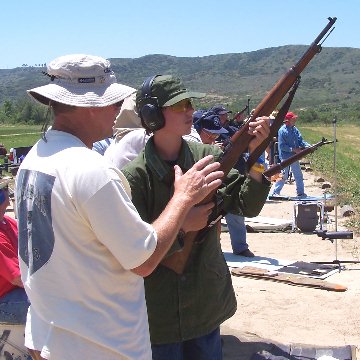
Ben receives expert instruction in his first high
power rifle match from Chief Warrant Officer Gene Rucks.
|
Ben and I were sent to the pits for the first three relays where we performed
our pit duties with precision team work. The morning was a little foggy with
very still air, but by the time we got out of the pits, the sun had burned off
the fog, and the wind was whipping up a bit. I let Ben take relay four and I
would shoot last.
Ben's vintage military competition rifle is a Swedish Model 96/38 born in 1900
at the Oberndorf Mauser plant in Germany. Originally a long M96, it was later
cut down to short rifle length.
Yeah, Ben had a few misses in his first high power match, particularly that
string of five misses he started off the standing stage with. After each shot,
Mr. Rucks would patiently explain to Ben what he was doing wrong, then on shot
six, he finally connected with the 7-ring. Then another 7, one more miss, a 6,
then a 5. A lot better than missing them all, that's for sure! Ben finished
with a score of 138-0x out of 300 possible. The good news was that he wasn't
the last place guy in the Vintage Military Rifle class.
So now it's finally my turn to shoot. I didn't start off too badly. In the
prone slow, I fired mostly 9s and 10s, no X's though, and I did drop a couple
8s and one 7. I finished with an 89 for prone slow.
Rapid fire prone is where I made my big mistake. I don't know if I've just been
lucky, or what, but I usually don't do too badly at rapid fire prone. Sometimes
I score higher in rapid fire than I do in slow fire. My mistake was in mentioning
my confidence in getting a decent score in this stage to Mr. Rucks. As soon as it
came out of my mouth I knew what a mistake it was. Now I was under pressure to
perform in front of the expert.
Basically, I just fell apart. I was just throwing those rounds at the target. Then
I fumbled the stripper reload. Two rounds got cockeyed and fell out of the receiver.
I managed to get one of the two back in before closing the bolt. I fired off those
four, and then had to stuff the last one in. Again, I just threw that last round down
range. What a fiasco! 72 points for the rapid fire stage. Amazingly though, no misses.
Now it was down to the standing stage. I ended up firing two misses in this string.
Those misses really kill you. The target rings count down from 10 to 5. There are no
4s or below. You drift out of the 5 ring and you get a big fat goose egg. I got an
even more dismal 67 for this string's total.
If you're adding this up, that makes a match total of 228 for 76% of 300 possible.
Uggh. That *$%&^ foreign POS! What's really funny is that of the 19 entries in the
foreign rifle class, that was still good enough for 6th place! Ben ended up 16th.
The top score in our class was 256-1x.
There were a total of 35 entries in the Springfield Match (top score 280-3x) and a
whopping 144 entries in the Garand Match (top score 288-8x). CWO Rucks finished 8th
out the 144 Garand entrants with a score of 276-2x.
May 22: Prescott
By chance I met a fellow Curio and Relic collector on a recent visit with my Mom who
now resides in Chino Valley. Ben and I were doing a little shooting in an old
abandoned quarry north of Chino when this guy pulls up to do some shooting of his own.
We get to talking and I find out that he's got a whole raft of C&R rifles with him.
Turns out that like me, he is also a member of Gunboards.com, the top internet site
for the discussion of C&R firearms. His screen name is Bullseye, but his real name
is Chris.
I mentioned that there was going to be a Prescott vintage military rifle match coming
up and asked whether he would be interested in shooting. He expressed some interest.
A week before the match, I emailed him to give him the details of what he needed to
bring and when to show up. Chris was there when I pulled into the parking area with
my two sons.
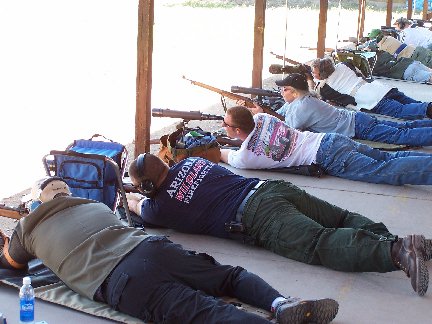
Relay 1 fires prone at the
Prescott Vintage Military
Rifle Match.
|
Chris had never fired in a high power match and wasn't sure what to expect. He still
wasn't sure that he wanted to shoot. He initially planned to come out just to watch.
I told him that he would just end up kicking himself later if he didn't shoot. He did
sign up to shoot the match.
We had arrived a little late. The first relay was already all filled up. Chris, my
two sons and I were assigned to the second relay.
The Prescott Sportsman's Club has been working on getting their 200 yard berm up to
snuff, but it still wasn't ready for today's shoot. We would be shooting the CMP "B"
course today, 5 sighters plus 50 shots for record, at 100 yards. The target is the
SR-1, which is the standard SR target reduced for 100 yards. The black on this target
(X, 10, and 9 rings) is 6-3/8" in diameter. This was a CMP sanctioned match so all the
CMP rules apply.
I was shooting the Finn M39, both Chris and Ben were shooting Swede M96/38s, and Sam
was shooting a Lee Enfield No. 4 Mk. 1*. Our old HSC buddy Bob Stoltz is the high
power chairman of the Prescott Sportsman's Club. He was shooting a borrowed '03A3
Springfield today. There were many Springfields noted on the line, both 1903s and
'03A3s. There were also a couple of U.S. M1917s, another No. 4 Lee Enfield, two other
Swedish Mausers, a couple of other miscellaneous Mausers, and one more Finn, an M27.
I believe there were 21 entries in the match. That's quite a turnout compared to the
six shooters who showed up for the Rio Salado match in the big city two weeks prior.
If I learned anything from my meltdown at the CMP match, it was that if you can just
keep them in the black, you will get a decent score. Above all else, avoid those
misses! Those were my primary goals in today's match. I worked hard to will
those shots into the black as best I could.
In the first 20 prone slow fire shots, I allowed only three to escape into the white.
All the rest were 9s and 10s. I again had three escapes out of 10 in the rapid fire
prone stage. But incredibly, in the rapid fire sitting stage there was only one escape
into the white! That old rapid-fire magic was back!
I finished the match with half of my 10 slow fire standing shots escaping into the
white, but no misses. When the smoke cleared, my total for the day was 449-2x for
89.8% of 500 possible points. That was good enough to win the match! Behind me were
two Springfield shooters who scored in the 430's. Chris scored a 382 - not bad at all
for his first match. The kids? Well let's just say that they're still developing.
High power boring? No way!

![]()
